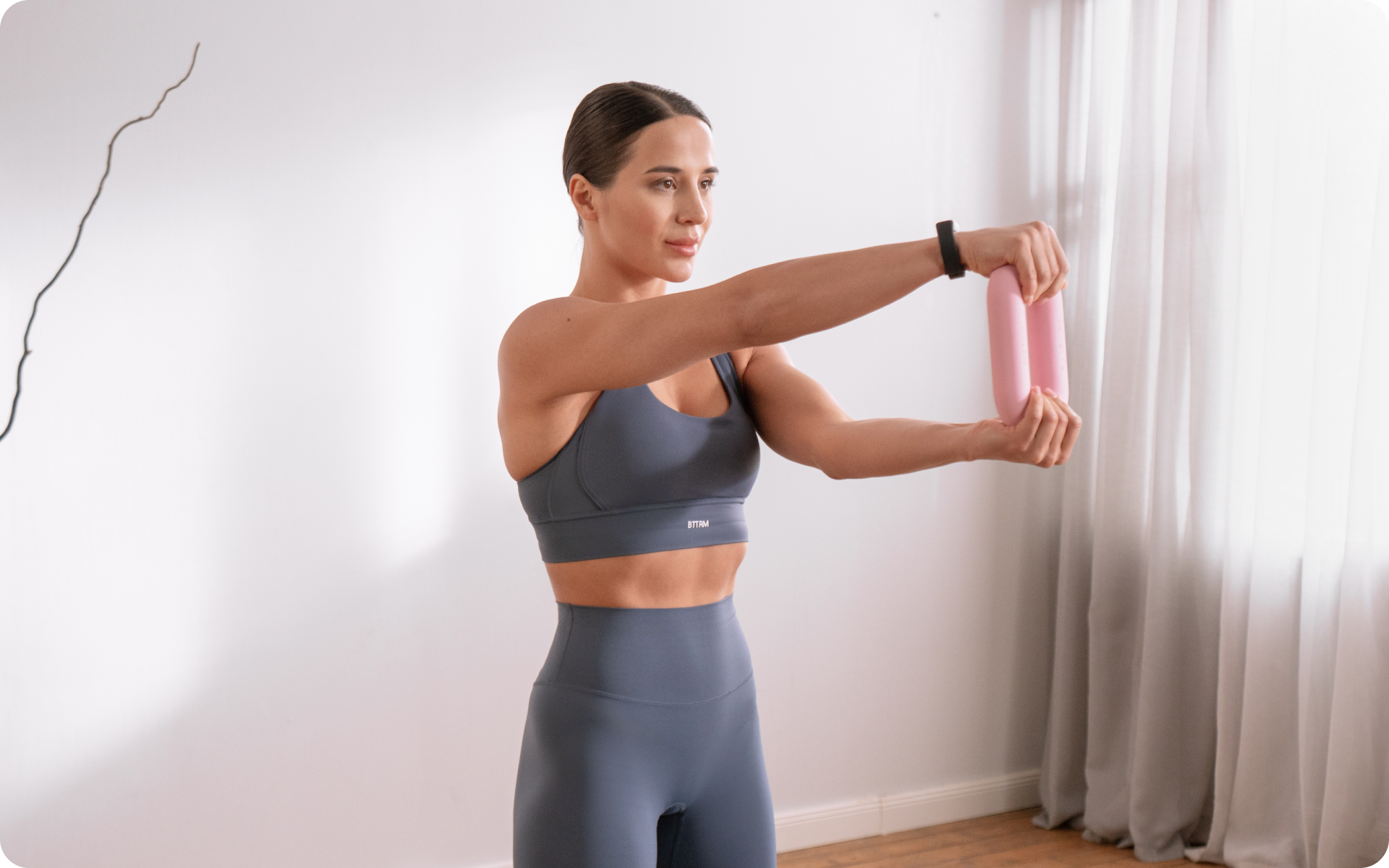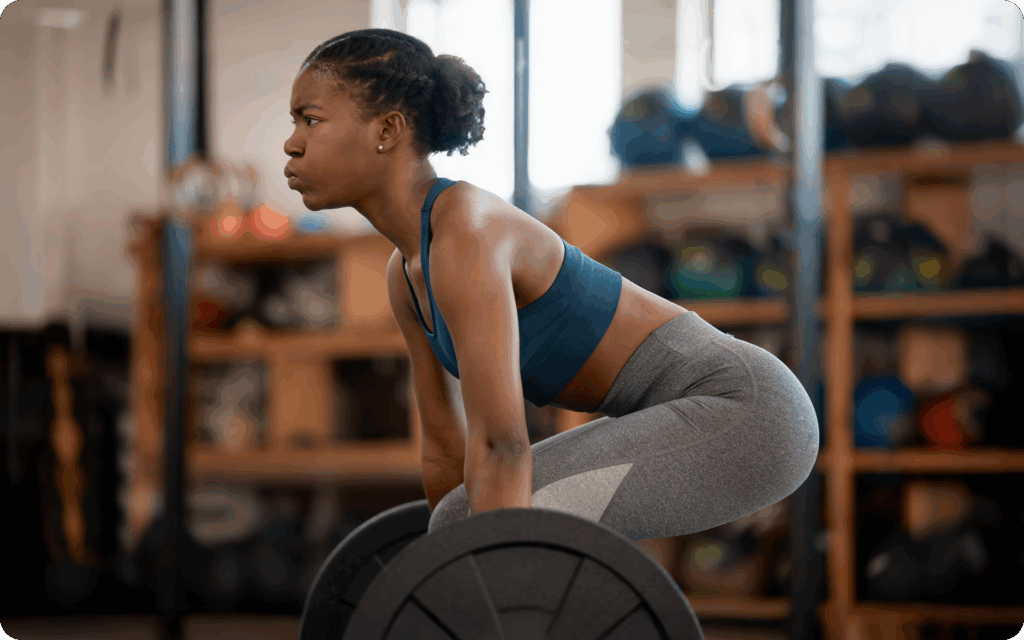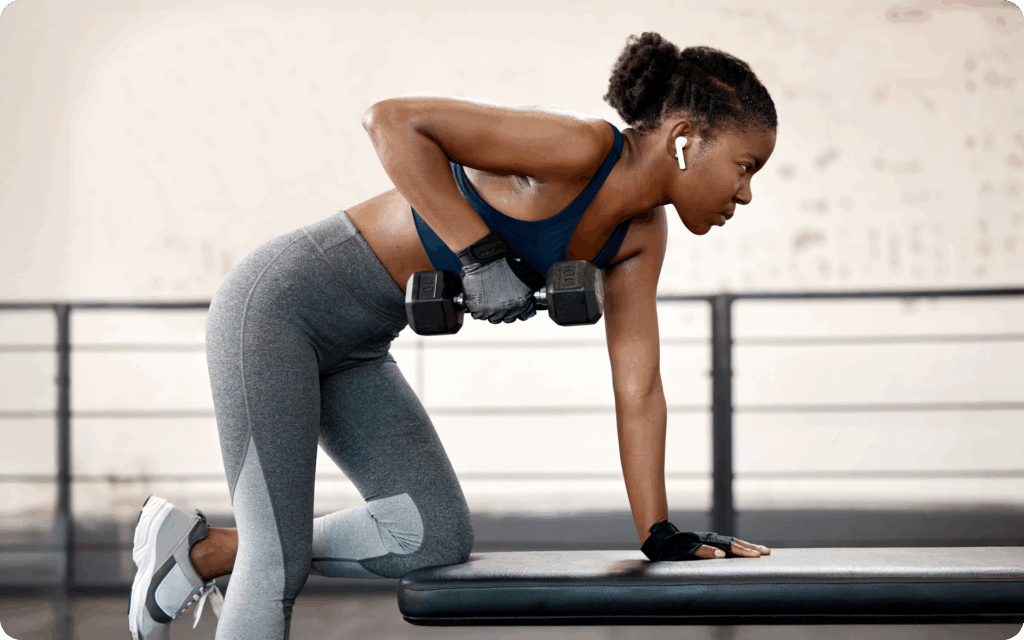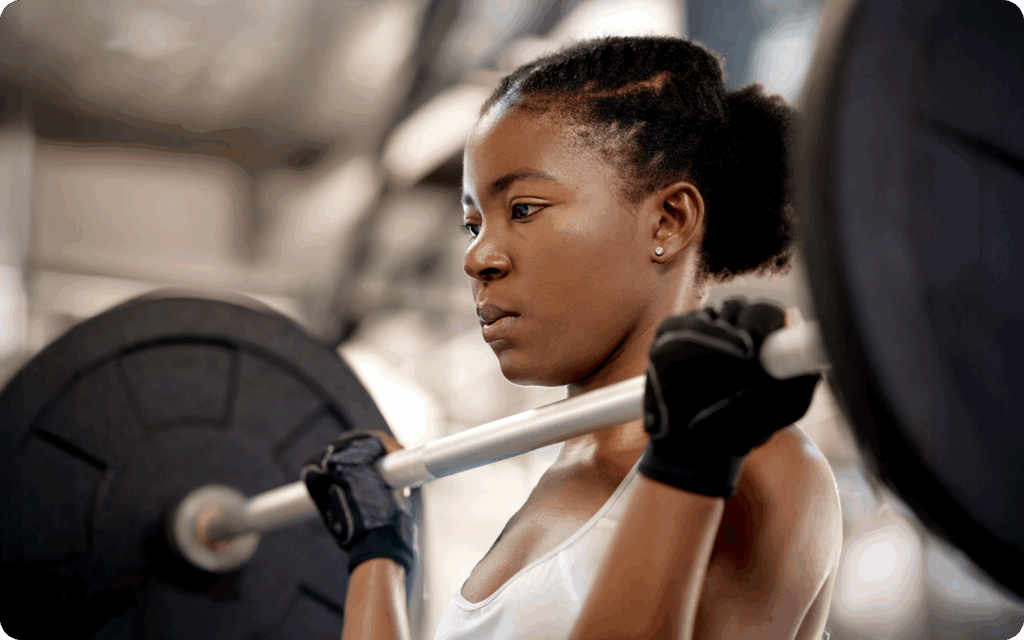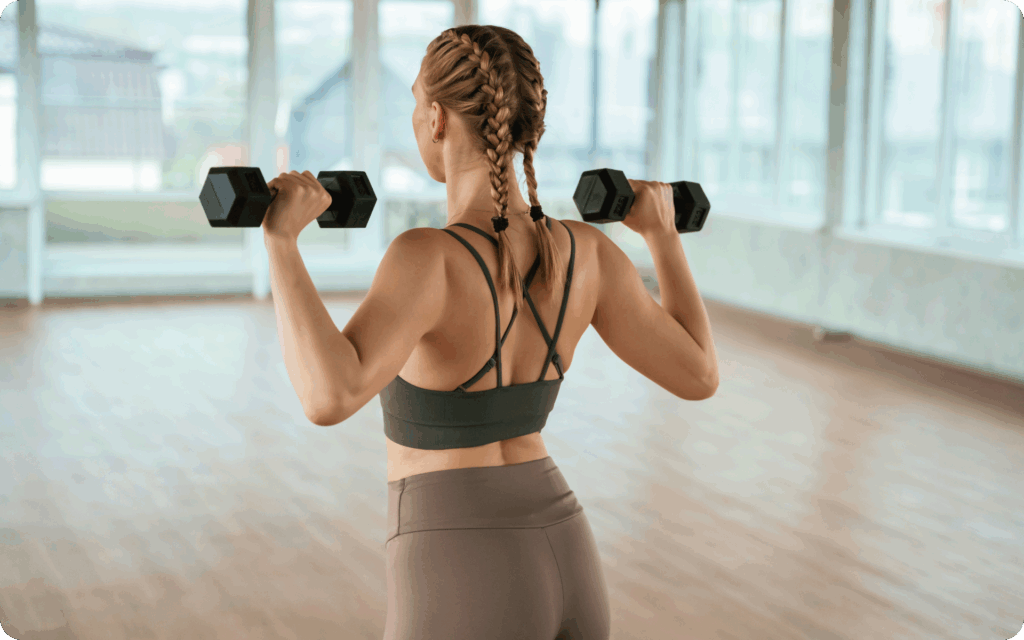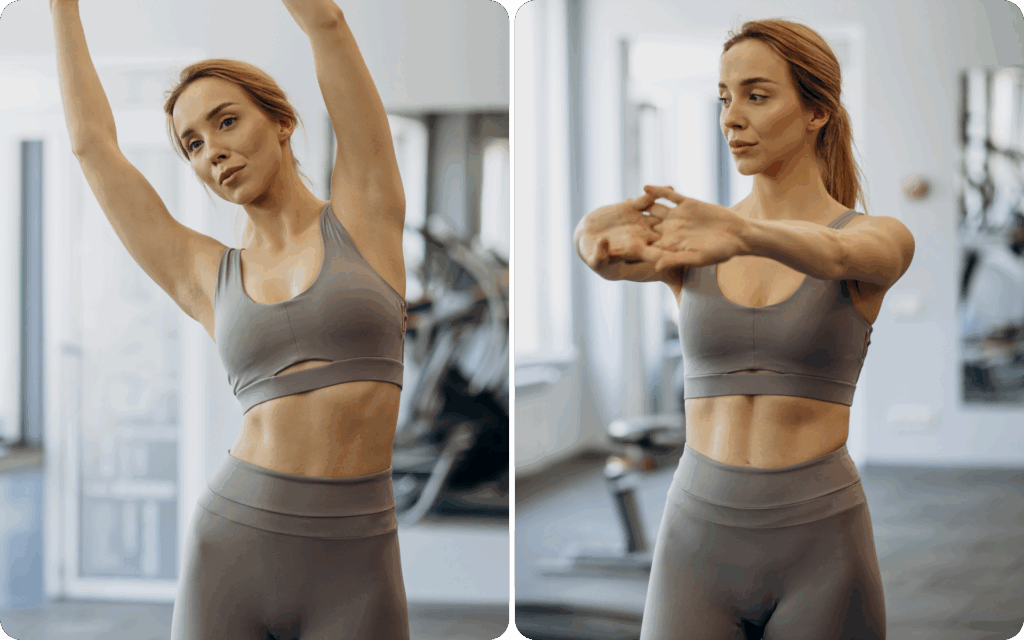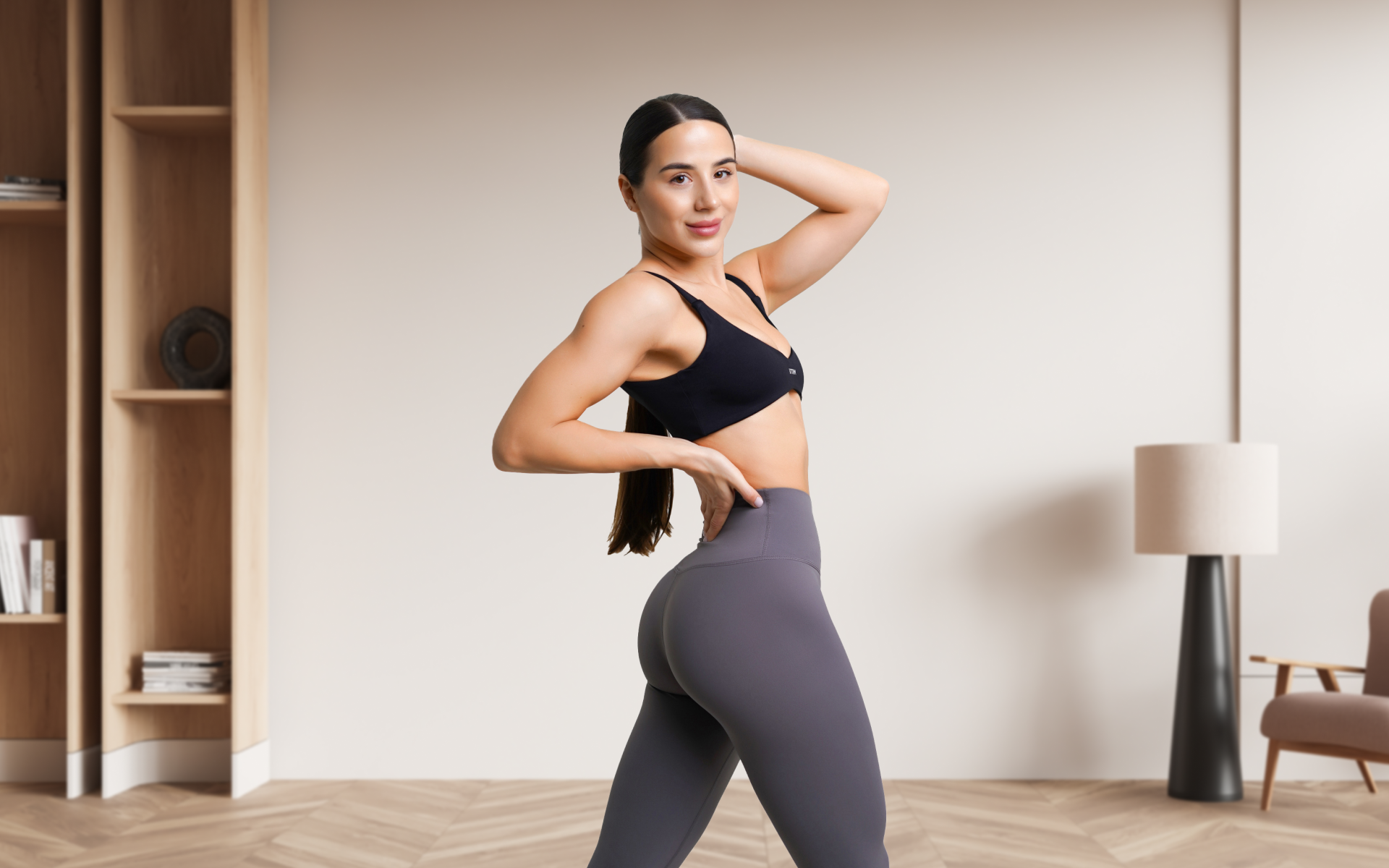The goal of simultaneously losing fat and gaining muscle, known as body recomposition, is often seen as the holy grail of fitness. Many believe you must choose between a “bulk” or a “cut”, but the science shows that with the right plan, you can achieve both. This guide provides an evidence-based workout and nutrition strategy to help you build a stronger, leaner physique.
We’ll break down the physiology, explain the programming, and give you a detailed plan to follow. By understanding the “how” and “why”, you can take control of your fitness journey and transform your body.
Should You Lose Fat or Build Muscle First?
Deciding whether to prioritize fat loss or muscle gain first depends on your starting body composition and training experience. As a general rule, your starting body fat percentage is the most important factor; leaner individuals (under 15% for men, 25% for women) should prioritize muscle gain, while those with higher body fat will benefit more from prioritizing fat loss.
Your experience level also matters. Beginners can build muscle and lose fat quite easily because their bodies are highly responsive to training. An intermediate or advanced lifter, who is closer to their genetic potential, will need a more dialed-in approach to continue making progress (1).
Here’s a simple breakdown:
- If you’re new to lifting or have a higher body fat percentage (over 20% for men, 30% for women): Prioritize fat loss by implementing a moderate caloric deficit. Your body has ample energy reserves (body fat) to fuel muscle growth even while you lose weight.
- If you’re already lean and have lifting experience: Prioritize muscle gain by eating at maintenance or in a slight caloric surplus. A deficit will likely hinder your ability to build new muscle tissue.
- If you’re “skinny fat” (normal weight but low muscle and high body fat): Body recomposition is the ideal approach. Start with a small caloric deficit (10-20% of your recommended daily calorie intake) to lower body fat and improve insulin sensitivity, then transition to maintenance calories to focus on muscle building.
BetterMe: Health Coaching app helps you achieve your body goals with ease and efficiency by helping to choose proper meal plans and effective workouts. Start using our app and you will see good results in a short time.
Can You Lose Fat and Gain Muscle Together?
Yes, you can absolutely lose fat and gain muscle at the same time, and this process is supported by scientific evidence. Body recomposition works because fat and muscle are two separate tissues. You can be in a net caloric deficit, prompting your body to “withdraw” energy from fat stores, while simultaneously providing a stimulus for muscle growth through resistance training and adequate protein intake, which “deposits” new muscle tissue (2).
Think of it like having two different bank accounts. You can withdraw $20 from one account (fat loss) while depositing $5 into another (muscle gain). Your net balance has decreased, but you still made a gain in one area. This is why the scale is not always the best indicator of progress.
Body recomposition is most common and happens most rapidly in four groups (1):
- New Lifters: Their bodies are hyper-responsive to training, which allows for rapid muscle growth fueled by stored body fat.
- Detrained Individuals: People with previous training experience who have taken a long break can regain muscle quickly due to “muscle memory”.
- Overweight or Obese Individuals: They have large energy reserves that can be used to build muscle even in a significant caloric deficit.
- Anabolic Steroid Users: Enhanced hormonal profiles allow for rapid muscle synthesis, often fueled by fat stores (3).
However, research has shown that even trained individuals can achieve body recomposition. Studies on collegiate athletes and highly trained lifters have demonstrated simultaneous fat loss and muscle gain when nutrition and training are properly managed (1). It is not an “impossible” goal, but one that requires a smart, consistent plan.
Read more: Beginner Gym Ab Workout Routine: 4 Exercises to Do
How to Build Muscle and Lose Fat for Females
The fundamental principles of body recomposition apply equally to men and women, but there are some nuances to consider for an effective workout plan for weight loss and muscle gain for females.
- Training: Women can and should train with the same intensity and focus on progressive overload as men. There is no need to stick to “light weights for toning”. Emphasize compound lifts and aim for the 12-20 weekly sets per muscle group (4).
- Nutrition: Caloric needs will generally be lower. It’s crucial to prioritize protein intake (around 1.4 – 2.0 g/kg) to preserve muscle mass in a deficit (5). As the deficit window is smaller, accuracy with food tracking is even more important.
- Menstrual Cycle: Hormonal fluctuations can impact energy, strength, and water retention (6, 7).
- Follicular Phase (first half): You may feel stronger and more energetic. This is a great time to push for new personal records in strength and volume.
- Luteal Phase (second half): You may experience more fatigue and water retention. It’s okay to reduce intensity slightly, focus on technique, and listen to your body. Don’t be discouraged by scale fluctuations during this time.
How Does a Body Recomposition Work?
A successful body recomposition plan works by strategically managing energy balance, macronutrients, and training to signal the body to build muscle and burn fat. It’s a more nuanced process than simply cutting or bulking, so tracking your progress is crucial. You’re no longer just chasing a number on the scale; you are reshaping your body’s composition.
To track your progress accurately, you need a “recomp toolkit”. This moves beyond just the scale to give you a complete picture of the changes happening.
Your Mandatory Recomposition Toolkit
- Weight Scale: Weigh yourself once a week, first thing in the morning after using the restroom and before eating or drinking. Be sure to write down your weekly weight to track any potential weight trends. Your body’s weight constantly changes throughout the day. These daily fluctuations from water, sodium, and carbs are normal and can be misleading when you’re weighing in daily.
- Measuring Tape: Measure your waist circumference at the belly button once or twice a month. A decreasing waist measurement is one of the most reliable signs of gaining muscle and losing fat, even if the scale isn’t moving. You can also track other body parts such as the chest, hips, and thighs to monitor where you’re building muscle.
- Progress Photos: Take front, side, and back photos 1-4 times per month in consistent lighting and poses. Photos can reveal visual changes in muscle definition and shape that numbers cannot capture.
- Food Scale & Tracking App: Accurately tracking your caloric and macronutrient intake is non-negotiable. A food scale is far more precise than measuring cups. Use an app like BetterMe to log your intake and ensure you are hitting your targets. Aim to be within +/- 10 grams for protein and carbs, and +/- 5 grams for fats.
By using these tools together, you can make informed adjustments to your plan. For instance, if your weight is stable but your waist is smaller and photos show more definition, you are successfully recomposing.
For those who are looking for an effective approach, explore the principles of a body recomposition diet.
Which Workout Is Best for Fat Loss and Muscle Gain?
The best workout for losing fat and gaining muscle is resistance training focused on progressive overload (1). While diet creates the caloric deficit needed for fat loss (8), weight training provides the essential stimulus for your body to build and retain muscle (9). Without it, a significant portion of weight lost in a deficit will come from muscle tissue.
Your workout plan should be built on a foundation of compound movements, supplemented with isolation exercises to target specific muscle groups.
Key Training Principles
- Progressive Overload: This is the cornerstone of muscle growth. You must gradually increase the stress placed on your muscles over time. This can be achieved by lifting more weight, performing more reps or sets, improving your form, or slowing down your tempo (10).
- Training Volume: Volume, often measured as total sets per muscle group per week, is a key driver of hypertrophy (muscle growth) (11). Research suggests a dose-response relationship, but more is not always better (12). Aim for 10-20 working sets per muscle group per week. Beginners should start at the lower end (10-12 sets) and gradually increase.
- Exercise Selection: Your program should prioritize multi-joint, compound exercises that engage large amounts of muscle mass. These are time-efficient and excellent for building foundational strength (13).
- Compound Lifts: Squat variations, deadlift variations, bench press, overhead press, rows, and pull-ups.
- Isolation Lifts: Include exercises like lateral raises, bicep curls, tricep extensions, and leg curls to target lagging muscles or areas you want to emphasize.
- Training Intensity (Effort): To stimulate growth, you must train with a high level of effort. This doesn’t mean every set has to go to absolute failure. A good guideline is to leave 1-3 reps in reserve (RIR) on most sets, especially for compound lifts (14). Isolation exercises can be taken closer to failure, but it’s often best to save this for the last set of an exercise.
- Rep Ranges: While muscle growth can occur across a wide spectrum of rep ranges, the most practical hypertrophy zone is 8-12 reps (15). This range allows you to use a challenging load while accumulating sufficient volume without the high injury risk of very heavy weights or the extreme metabolic fatigue of very high-rep sets.
Read more: 3-Day Full-Body Workout Plan at Home (Dumbbell Only Required)
What Is an Effective Lose Fat Gain Muscle Workout Plan?
An effective plan combines the principles above into a structured, progressive weekly schedule.
Training frequency is also important; research shows that training a muscle group twice per week is generally superior for hypertrophy compared to once per week (16). This makes “bro splits” (e.g. chest day, back day) less optimal for most people.
Instead, splits like 3-day full-body or 4-day upper/lower allow you to hit each muscle group twice within a week.
Sample 12-Week Workout Plan Structure
This program is designed to be flexible. You can have a 4-day upper/lower split, or a 3-day full-body workout. The exercises listed are examples – feel free to substitute with similar movements based on equipment availability and preference.
Keep movement patterns consistent (squat/hinge/push/pull) and swap only like-for-like (e.g. barbell row → chest-supported row) if needed.
Program notes:
- Frequency: Train each muscle group 2x/week (4-day upper/lower) or 2x/week average over 10-14 days (3-day full-body).
- Weekly sets per muscle: 10-20 total working sets. Beginners start at 10-12; intermediates 12-16; advanced 14-20.
- Reps: Use a practical hypertrophy zone of 8-12 reps on most work. Isolation can go 12-20 reps.
- Rest intervals: 90-120 seconds for most sets; 2-3 minutes for heavy compounds to preserve performance.
- Effort targets (RIR = reps in reserve): Compounds 1-3 RIR; isolations 0-2 RIR (last set to 0-1 RIR as desired).
- Tempo/form: Controlled lowering (2-3 seconds) and stable positions; aim for consistent ROM across weeks.
Rest Periods:
- Compound Lifts (Squats, Bench, Deadlifts, Rows): 2-3 minutes.
- Accessory/Isolation Lifts: 90-120 seconds. A 2024 meta-analysis found a small benefit for hypertrophy with rest intervals over 60 seconds, with diminishing returns after 90-120 seconds (17). Longer rests help preserve volume load, a key driver of growth.
Progression:
- Weeks 1-4 (Accumulation): Focus on mastering form and adding reps. Aim to increase reps each week within the target range. Once you hit the top of the rep range, increase the weight.
- Weeks 5-8 (Intensification): Focus on increasing the load. The reps may slightly decrease as you add weight, but aim to work back up.
- Weeks 9-12 (Peak/Deload): Continue pushing the load. In week 12, reduce your volume and intensity by about 50% (a deload) to allow for full recovery before starting a new cycle.
Option 1: 4-Day Upper/Lower Split
Day 1: Upper Body
- Lat pulldown: 3 sets of 10-12 reps (1 RIR)
- Bench press: 3 sets of 6-8 reps (2 RIR)
- Bent-over barbell row: 3 sets of 6-8 reps (2 RIR)
- Overhead press: 3 sets of 8-10 reps (1-2 RIR)
- Tricep pushdown: 2 sets of 12-15 reps (0-1 RIR)
- Dumbbell lateral raise: 3 sets of 12-15 reps (0-1 RIR)
Day 2: Lower Body
- Barbell back squat: 3 sets of 6-8 reps (2 RIR)
- Romanian deadlift: 3 sets of 8-10 reps (2 RIR)
- Leg press: 3 sets of 10-12 reps (1 RIR/ Heavy)
- Seated hamstring curl: 3 sets of 12-15 reps (1 RIR)
- Standing calf raise: 4 sets of 10-15 reps (0-1 RIR)
- Cable crunch: 3 sets of 15-20 reps (0-1 RIR)
Day 3: Rest or Active Recovery
Whether you’re a workout beast or just a beginner making your first foray into the world of fitness and dieting – BetterMe has a lot to offer to both newbies and experts! Install the app and experience the versatility first-hand!
Day 4: Upper Body
- Incline dumbbell press: 4 sets of 8-12 reps (1 RIR)
- Seated cable row: 4 sets of 10-15 reps (1 RIR)
- Machine shoulder press: 3 sets of 10-15 reps (1 RIR)
- Dumbbell curl: 3 sets of 10-15 reps (0-1 RIR)
- Overhead tricep extension: 3 sets of 10-15 reps (0-1 RIR)
- Reverse pec deck: 3 sets of 15-20 reps (0 RIR)
Day 5: Lower Body
- Leg press: 4 sets of 10-15 reps (1 RIR/ lighter than day 2’s session)
- Dumbbell lunges: 3 sets of 10-12 reps per leg (1 RIR)
- Single leg deadlift: 3 sets of 12-15 reps per leg (0-1 RIR)
- Quad extension: 3 sets of 12-15 reps (0-1 RIR)
- Seated calf raise: 4 sets of 15-20 reps (0-1 RIR)
- Hanging leg raise: 3 sets to failure (0 RIR)
Days 6 and 7: Rest or Active Recovery
Option 2: 4-Day Body Part Split (with 2x frequency for key areas)
- Day 1: Upper body (push/pull focus)
- Day 2: Lower body (quad focus)
- Day 3: Rest
- Day 4: Push (chest, shoulders, triceps)
- Day 5: Pull (back, biceps)
- Day 6: Lower body (hamstring/glute focus)
- Day 7: Rest
Option 2: 3-Day Full-Body plan (12-week progression)
Day 1: Full Body A
- Squat (high- or low-bar): 3×6-8 (2 RIR)
- Bench press (flat): 3×6-8 (2 RIR)
- Row (barbell or chest-supported): 3×8-10 (1-2 RIR)
- Chest fly 3×8-12 (1-2 RIR)
- Dumbbell lateral raise: 2-3×12-15 (0-1 RIR)
- Cable curl: 2×10-12 (0-1 RIR)
- Cable triceps pressdown: 2×10-12 (0-1 RIR)
Day 2: Rest or Active Recovery
Day 3: Full Body B
- Deadlift (conventional or trap bar): 3×4-6 (2-3 RIR)
- Lat pulldown 3×8-10 (1-2 RIR)
- Incline DB press: 3×8-10 (1-2 RIR)
- Split squat (DB/BB): 3×8-10/leg (1-2 RIR)
- Reverse pec deck: 2-3×12-15 (0-1 RIR)
- Seated leg curl: 2×12-15 (0-1 RIR)
- Hanging leg raise or cable crunch: 2-3 sets (0-1 RIR)
Day 4: Rest
Day 5: Full Body C
- Pull-up: 3×8-10 (1 RIR)
- Hip thrust (BB/Smith): 3×8-12 (1-2 RIR)
- Goblet front squat (or hack/leg press): 3×6-8 (2 RIR)
- Overhead press (BB/DB): 3×8-10 (1-2 RIR)
- Overhead chest-supported row: 3×8-12 (1-2 RIR)
- Leg extension: 2-3×12-15 (0-1 RIR)
- Seated or standing calf raise: 3×10-15 (0-1 RIR)
- Side plank or Pallof press: 2-3 sets (0-1 RIR)
Days 6 and 7: Rest or Active Recovery
Lose Fat Gain Muscle Workout Plan at Home (Minimal Equipment)
No gym? No problem. You can still achieve great results with minimal equipment such as resistance bands and dumbbells. The key is to apply progressive overload by increasing reps, adding sets, or using more challenging exercise variations.
For more ideas on how to craft a program that works for you, check out the best way to gain muscle and lose fat.
What Cardio Is Best for Muscle Gain and Fat Loss?
The best cardio for muscle gain and fat loss is the type that interferes the least with your resistance training recovery and performance. Since your primary muscle-building stimulus comes from lifting, cardio should be used as a tool to help create a larger daily caloric deficit, not as the main driver of hypertrophy. An “effective minimum” approach could be considered the best. It really comes down to your fitness goals and what you want to get out of your training.
Low-Intensity Steady State (LISS)
This is the preferred form of cardio for body recomposition. LISS, such as incline walking, cycling, or using the elliptical at a moderate pace (around 60-70% of max heart rate), is easy to recover from and has a minimal impact on strength and hypertrophy (18).
Frequency: 1-3 sessions per week.
Duration: 20-45 minutes per session.
High-Intensity Interval Training (HIIT)
HIIT involves short bursts of all-out effort followed by recovery periods (e.g. 30 seconds sprinting, 60 seconds walking) (19). While this is time-efficient, it can be very taxing on the central nervous system and interfere with lifting recovery.
Frequency: Use sparingly, a maximum of 1-2 sessions per week.
Placement: Perform HIIT on a separate day from heavy leg training or after your lifting session, never before.
Non-Exercise Activity Thermogenesis (NEAT)
NEAT is the energy you burn from daily activities outside of formal exercise, such as walking, fidgeting, or taking the stairs (20). Increasing your NEAT by aiming for a daily step goal (e.g. 8,000-10,000 steps) is a highly effective, low-impact way to increase calorie expenditure without causing training fatigue.
Why Am I Gaining Muscle but Not Losing Fat?
If you’re gaining muscle but not losing fat, the simple answer is that you are not in a consistent caloric deficit. While resistance training sends the signal to build muscle, fat loss is dictated by energy balance (21). Your body will not tap into its fat stores for energy if you are providing it with enough (or too many) calories from food.
Here are the most common reasons this happens and how to fix them:
- Your Caloric Intake Is Too High
You might be accurately tracking your workouts and protein, but you are consuming too many calories overall. This is often unintentional, caused by underestimating portion sizes, “hidden” calories in sauces and oils, or weekend splurges that offset your weekday discipline.
The Fix: Use the “mandatory toolkit” to conduct a monthly self-assessment. If your weekly average weight is increasing or stagnant and your waist measurement isn’t decreasing, reduce your daily caloric intake by 100-250 calories. Remove these calories from carbs and/or fats, but never protein.
- You’re Not Active Enough
Your structured workouts are great, but your total daily energy expenditure (TDEE) is lower than you think. A sedentary job or lifestyle outside the gym means your “calories out” are low.
The Fix: Instead of cutting more calories, increase your activity. Add one or two 30-minute LISS cardio sessions per week, or focus on increasing your NEAT by setting a daily step goal.
- Hormonal Factors and Poor Recovery
Lack of sleep and high stress levels can sabotage fat loss. Sleep deprivation and stress raises cortisol and ghrelin (the hunger hormone), which makes it harder to stick to your diet and encourages fat storage (22, 23).
The Fix: Prioritize 7-9 hours of quality sleep per night. Implement stress management techniques like meditation, walking, or enjoyable hobbies. Recovery isn’t always passive; it’s an active part of your plan.
Weightlifting is more effective for long-term fat loss than cardio. While a cardio session might burn more calories minute-for-minute (24), resistance training builds muscle, which increases your resting metabolic rate (25). This means you burn more calories 24/7, even at rest. The best approach combines weight training as the foundation with cardio used as a tool to increase the caloric deficit and improve cardiovascular performance. Whether fasting burns fat or muscle depends on the context, particularly your protein intake and training stimulus. In a caloric deficit, your body will break down both fat and muscle for energy. However, combining fasting with high-protein meals during your eating window and consistent resistance training can help preserve (and even build) muscle while prioritizing fat as the primary fuel source (26). Very long fasts with inadequate protein are more likely to result in muscle loss (27). For individuals engaged in resistance training for body recomposition, a protein intake of approximately 1.5 grams per kilogram of body weight per day (or about 0.7 grams per pound) is a scientifically supported target (28). Research has shown that this amount synergistically enhances the effects of resistance training on muscle mass and strength. Some evidence suggests a sliding scale of 1.2-1.6 g/lb of lean body mass, with leaner individuals needing more (29). Consuming more than 1.6 g/kg/day has shown diminishing returns for most people (30). Yes, you should try your best to continue to lift heavy when cutting (in a caloric deficit). Lifting with intensity sends a strong signal to your body to retain muscle mass. If you switch to light weights and high reps, you remove the primary stimulus for maintaining strength and muscle. Your goal should be to maintain your strength as much as possible; this is a key sign that you are preserving muscle tissue while losing fat. However, you should remember that being in a calorie deficit means that you are providing your body with less energy each day. This could potentially lead to decreases in strength as you continue to drop body fat, so don’t be alarmed if you’re not hitting PRs in every gym session. Frequently Asked Questions
Does cardio or weightlifting burn more fat?
Does fasting burn fat or muscle?
How much protein is needed to gain muscle?
Should I lift heavy when cutting?
The Bottom Line
Body recomposition is an achievable goal that requires a smart, evidence-based approach. The synergy between progressive resistance training and a high-protein, calorie-controlled diet is the engine of your transformation. Forget the myth that you must choose between losing fat or gaining muscle. By implementing the principles and plans in this guide, you can do both.
Use the tracking tools to monitor your progress, be patient and consistent, and make adjustments based on the data. Your body is an adaptable machine, and with the right inputs, you can guide it toward the strong, lean physique you desire.
If you want to create a personalized eating strategy, learn about the best diet for weight loss and muscle gain.
DISCLAIMER:
This article is intended for general informational purposes only and does not serve to address individual circumstances. It is not a substitute for professional advice or help and should not be relied on for making any kind of decision-making. Any action taken as a direct or indirect result of the information in this article is entirely at your own risk and is your sole responsibility.
BetterMe, its content staff, and its medical advisors accept no responsibility for inaccuracies, errors, misstatements, inconsistencies, or omissions and specifically disclaim any liability, loss or risk, personal, professional or otherwise, which may be incurred as a consequence, directly or indirectly, of the use and/or application of any content.
You should always seek the advice of your physician or other qualified health provider with any questions you may have regarding a medical condition or your specific situation. Never disregard professional medical advice or delay seeking it because of BetterMe content. If you suspect or think you may have a medical emergency, call your doctor.
SOURCES:
- Body Recomposition: Can Trained Individuals Build Muscle and Lose Fat at the Same Time? (2020, journals.lww.com)
- Editorial: New insights and advances in body recomposition (2024, frontiersin.org)
- Anabolic–androgenic steroids: How do they work and what are the risks? (2020, rontiersin.org)
- A Systematic Review of The Effects of Different Resistance Training Volumes on Muscle Hypertrophy (2022, pmc.ncbi.nlm.nih.gov)
- Preserving Healthy Muscle during Weight Loss (2017, sciencedirect.com)
- Menstrual Cycle and Physical Activity (n.d., physio-pedia.com)
- Fluid Retention over the Menstrual Cycle: 1-Year Data from the Prospective Ovulation Cohort (2011, pmc.ncbi.nlm.nih.gov)
- Optimal Diet Strategies for Weight Loss and Weight Loss Maintenance (2020, pmc.ncbi.nlm.nih.gov)
- Effect weight training on muscular hypertrophy: a systematic review (2023, researchgate.net)
- Progressive Overload Explained: Grow Muscle & Strength Today (n.d., blog.nasm.org)
- Resistance Training Variables for Optimization of Muscle Hypertrophy: An Umbrella Review (2020, frontiersin.org)
- Training volume increases or maintenance based on previous volume: the effects on muscular adaptations in trained males (2024, journals.physiology.org)
- Progression Models in Resistance Training for Healthy Adults (2009, journals.lww.com)
- Influence of Resistance Training Proximity-to-Failure, Determined by Repetitions-in-Reserve, on Neuromuscular Fatigue in Resistance-Trained Males and Females (2024, sportsmedicine-open.springeropen.com)
- Loading Recommendations for Muscle Strength, Hypertrophy, and Local Endurance: A Re-Examination of the Repetition Continuum (2021, pmc.ncbi.nlm.nih.gov)
- Effects of Resistance Training Frequency on Measures of Muscle Hypertrophy: A Systematic Review and Meta-Analysis (2016, link.springer.com)
- Give it a rest: a systematic review with Bayesian meta-analysis on the effect of inter-set rest interval duration on muscle hypertrophy (2024, frontiersin.org)
- Evidence-Based Effects of High-Intensity Interval Training on Exercise Capacity and Health: A Review with Historical Perspective (2021, pmc.ncbi.nlm.nih.gov)
- Non-exercise activity thermogenesis (NEAT) (2002, pubmed.ncbi.nlm.nih.gov)
- “Calories in, calories out” and macronutrient intake: the hope, hype, and science of calories (2017, journals.physiology.org)
- Sleep Deprivation: Effects on Weight Loss and Weight Loss Maintenance (2022, pmc.ncbi.nlm.nih.gov)
- Stress and Obesity (2019, annualreviews.org)
- Exercises That Burn the Most Calories (2024, health.clevelandclinic.org)
- Increasing muscle mass to improve metabolism (2013, pmc.ncbi.nlm.nih.gov)
- The Effects of Intermittent Fasting Combined with Resistance Training on Lean Body Mass: A Systematic Review of Human Studies (2020, pmc.ncbi.nlm.nih.gov)
- Skeletal Muscle Responses to Negative Energy Balance: Effects of Dietary Protein (2012, sciencedirect.com)
- Effects of Dietary Protein on Body Composition in Exercising Individuals (2020, pmc.ncbi.nlm.nih.gov)
- Systematic review and meta‐analysis of protein intake to support muscle mass and function in healthy adults (2022, pmc.ncbi.nlm.nih.gov)
- A systematic review, meta-analysis and meta-regression of the effect of protein supplementation on resistance training-induced gains in muscle mass and strength in healthy adults (2017, pmc.ncbi.nlm.nih.gov)
